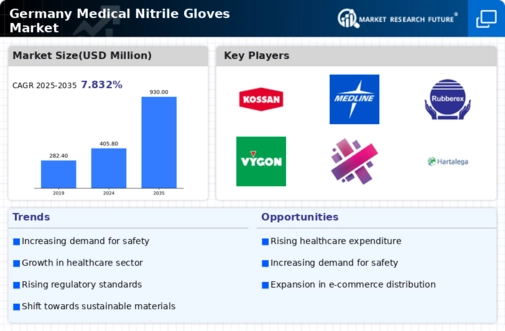Increased Healthcare Expenditure
Germany's healthcare expenditure has been on an upward trajectory, which positively impacts the medical nitrile-gloves market. With the government allocating a substantial budget to healthcare, hospitals and clinics are increasingly investing in high-quality medical supplies, including nitrile gloves. In 2025, healthcare spending is expected to reach around €500 billion, indicating a robust commitment to improving healthcare infrastructure. This increase in funding allows healthcare facilities to prioritize safety and hygiene, leading to a higher demand for nitrile gloves. Furthermore, as healthcare providers seek to enhance patient care and minimize infection risks, the preference for nitrile gloves over latex alternatives is likely to grow. This trend suggests a promising outlook for the medical nitrile-gloves market, as healthcare facilities strive to meet the evolving needs of patients and regulatory bodies.
Regulatory Compliance and Standards
The medical nitrile-gloves market in Germany is significantly influenced by stringent regulatory compliance and standards set by health authorities. These regulations ensure that gloves meet safety and quality benchmarks, which is crucial for healthcare providers. The German Institute for Standardization (DIN) and the European Union's Medical Device Regulation (MDR) impose rigorous testing and certification processes. As a result, manufacturers are compelled to invest in high-quality materials and production techniques to comply with these standards. This focus on compliance not only enhances product safety but also boosts consumer confidence in nitrile gloves. Consequently, the demand for compliant products is expected to rise, driving growth in the medical nitrile-gloves market. The market is projected to expand at a CAGR of approximately 6% over the next few years, reflecting the increasing emphasis on regulatory adherence.
Shift Towards Non-Latex Alternatives
The medical nitrile-gloves market is experiencing a notable shift towards non-latex alternatives, driven by the increasing prevalence of latex allergies among healthcare workers and patients. This trend is particularly relevant in Germany, where awareness of latex sensitivities has prompted healthcare providers to seek safer options. Nitrile gloves, known for their hypoallergenic properties, are becoming the preferred choice in various medical settings. As a result, manufacturers are focusing on expanding their nitrile glove product lines to cater to this growing demand. The market is likely to see a surge in innovation, with companies developing new formulations and designs to enhance comfort and usability. This shift not only addresses health concerns but also positions the medical nitrile-gloves market for sustained growth as more healthcare facilities transition away from latex products.
Growing Awareness of Infection Control
The rising awareness of infection control measures among healthcare professionals and the general public is a key driver for the medical nitrile-gloves market in Germany. As healthcare-associated infections (HAIs) remain a concern, the emphasis on protective equipment, including nitrile gloves, has intensified. Educational campaigns and training programs aimed at healthcare workers have highlighted the importance of using appropriate personal protective equipment (PPE) to prevent the spread of infections. This heightened awareness is likely to lead to increased consumption of nitrile gloves, as they are recognized for their superior barrier protection compared to other materials. The medical nitrile-gloves market is expected to benefit from this trend, as healthcare facilities prioritize infection control protocols and invest in high-quality gloves to safeguard both patients and staff.
Technological Innovations in Manufacturing
Technological innovations in manufacturing processes are playing a crucial role in shaping the medical nitrile-gloves market in Germany. Advances in production techniques, such as automated manufacturing and improved quality control systems, are enabling manufacturers to enhance efficiency and reduce costs. These innovations allow for the production of high-quality nitrile gloves at a lower price point, making them more accessible to healthcare providers. Additionally, the integration of smart technologies in manufacturing processes is expected to improve product consistency and safety. As manufacturers adopt these technologies, the medical nitrile-gloves market is likely to witness increased competition and a broader range of product offerings. This dynamic environment may lead to further growth opportunities as healthcare facilities seek reliable and cost-effective solutions for their protective equipment needs.




















Leave a Comment